Memory Systems
Why You Need a Memory System
To become proficient in a language, you need to incorporate large amounts of linguistic and cultural knowledge into your memory and you need to be able to use that knowledge to understand and to communicate in the language. The perennial challenge for language learners is how to best commit this information to memory in ways that will facilitate using the language in real life.
At the Five College Center for the Study of World Languages, we have been working with independent language learners for over twenty-five years. One of the major differences between successful students and those who struggle is that successful students develop for themselves one or more systems to keep track of the vocabulary and grammatical constructions that they are learning. Then, they use that system as the starting point for practicing what they are learning and for reviewing and testing themselves repeatedly.
Although some linguistic and cultural information will just sink in on first encounter or through repeated exposure, most adult learners need to give explicit attention to learning vocabulary and grammar in order to make significant progress. Children acquire their home language(s) over multiple years through repeated exposure and endless trial and error aided by everyone around them. As an adult language learner, you have the capacity to speed this process along by deliberately choosing effective learning techniques and making those techniques the foundation of your study.
Most of our successful students use flashcard systems, notebook systems, or some combination of the two. Individuals have their own learning styles and have different learning goals. The systems you choose may not be the same as those of other learners, and the systems you use may evolve over time.
There are many different ways flashcards can be used (both the paper kind and new online flashcard apps) and many different ways notebooks or other note-based systems can be used. Go to the other sections under Memory Systems to read about many different options and see what appeals to you.
As you explore options, keep in mind some basic principles:
- The more powerful systems allow you to organize information for yourself and make your own decisions about how you will incorporate that information into memory. The process of encountering the information, thinking about how to best remember it and organizing it in your own way is in and of itself a memory building process.
- Whether you are using flashcards, notebook word lists, or some other technique, memory is helped by incorporating both word and image-based memory association techniques. This is especially helpful when you are learning languages for which there are few cognates with English words (or with another language you know well). For suggestions about this, see all the techniques outlined in the other articles in Memory Systems.
- Retrieving information from memory in order to use it is facilitated by learning vocabulary and grammar in meaningful contexts. It is helpful to learn “chunks” of language – sample phrases, expressions, and whole sentences that incorporate vocabulary and grammatical patterns. You can adapt flashcard and notebook techniques to facilitate learning language in chunks and in context.
- Your system needs to include points where you practice recalling vocabulary or grammatical patterns and using the information immediately to create meaning. Compose sentences, questions, and answers to questions. Imagine yourself in scenarios where you might use that word or pattern and make up language (spoken or written) that uses it in that context. Do this on your own and then use your conversation sessions and other conversational opportunities to deliberately try to use the vocabulary and patterns when speaking with others (For more information about what ot do in your sessions, see the articles under: Conversation Sessions).
- Regardless of which system you are using, avoid focusing on translating from the language back into English (or any other language in which you are fluent). That is translation practice, not practice that will help you recall the information in order to use the language. Although some occasional translation practice is fine (especially if you want to be a translator), if you focus on translating as your main language learning activity, you will not immerse yourself in the thought-world of the language. For the language to become automatic and natural to you, you need to get into that world and not be translating everything back into English in your head.
Why Use Flashcards?
When you learn a language, you have to be ready to learn and commit to memory thousands of items of information during your time learning it. Unless you have photographic memory, you will need some external way to both keep track of what you have already learned and learn new words and concepts that you encounter over time.
Flashcards, as mundane and traditional as they may seem, are among the bests methods for learning and retaining large amounts of information over time. There are many reasons for this:
- The process of making a flashcard is, in itself, a way to form a memory. So when you put a new word on one side and a picture or definition on the other, you are already practicing the association between the two items of information. It’s important to make your own set for this very reason, instead of borrowing other people’s.
- Flashcards can be reviewed. So after you have put in the time to make cards for vocabulary or new grammatical structures and have practiced until they are memorized, you can revisit the cards again after a certain amount of time and refresh your memory. This is very important, since everything in learning a language builds on what you already have learned about it.
- Flashcards help organize study and give you a sense of accomplishment. While learning something as massive and detailed as a language, it can be hard to keep your study regular and structured and to keep motivation up. When you study flashcards, you just work with one word at a time, and each time you successfully remember a word or construction it will give you a concrete, positive result of what you are able to learn. When repeated almost-daily and done in chunks instead of all at once, flashcards can even be a lot of fun.
In our list of flashcard resources, you will see that most of the electronic flashcard programs are Spaced Repetition Software (SRS). An SRS program makes you rate how well you remember each card whenever you review it on a scale (the lowest score, for example, could be “Don’t remember”, and the highest score could be “Easy”).
It takes this information and brings back a certain number of cards each day for review, showing cards that you had a harder time with sooner and more often, and putting longer amounts of time between the review of cards that were easier for you.
For different ways to use flashcards, refer to:
- The other articles on flashcards in this section.
- Another good resource for using flashcards in language learning is the book Fluent Forever by Gabriel Wyner. You can find resources to help your own languages study and parts of his excellent book on his website.
Of course, flashcards will only help so much without an effective plan for studying. For tips on structuring your language study, see the articles under How to Study.
Resources for Making Flashcards
Although there is nothing wrong with making traditional paper flashcards, there are many online services and programs you can download that both allow you to make flashcards in a more traditional style as well as to use pictures or sounds or otherwise customize your ‘cards’ in many useful ways. What follows is a list of a few flashcard websites or programs you can use, with descriptions of how they work and some of their strengths and weaknesses.
Unless otherwise noted, these are all Spaced Repetitions Software (SRS), which have you rate each card while you work through a deck, based on how easy it is to recall. Using this data, the system brings back cards for review each day. This way you get more time to review cards that are harder in the short term, and in the long term, just as you are starting to forget some of the cards that were easier at first, they will be brought back automatically for review by the program.
- Anki: This program can be downloaded on both your smartphone and your computer. The computer application is free, but the official phone app is quite expensive if you have an iPhone. The phone app is free for Android phones. If you create a user profile in the program, you can sync your data between systems when you use the program. This means whatever system you use it on, you will be able to maintain your learning schedule. Anki allows you to create flashcards with more than just two “front” and “back” fields, and you can also create customized card types for different languages or subjects. Cards can include pictures and audio either copied from the internet or uploaded from your computer. The interface is somewhat outdated and clunky, but with the help of the manual on the Anki website, you can find out quickly how to navigate it.
- Mnemosyne: This program only exists as a computer application; there is no smartphone app. Mnemosyne is free to download. Compared to Anki, you have much less ability to customize the cards you add to your decks, since there are only three pre-programmed card types. You can add pictures and audio as well as text to your cards.
- Repetitions: Repetitions is very similar to Mnemosyne. The interface is slightly different, but it is similarly restricted to only three card types, and the cards can include any pictures or audio that you upload or copy and paste into the program. Unlike Mnemosyne and Anki, however, Repetitions comes with a free phone app for all platforms that automatically syncs with your computer, so you can keep up with your learning schedule even while you are on the move.
- Quizlet: Quizlet is a very popular online flashcard service that is free and exists both in an online and phone-app form. It is not an SRS, though, so you have to spend time managing your own review schedule for your flashcards. Also, to add pictures or audio to your cards, you have to take part in the paid membership plan. Otherwise you can only use text and pictures from the set of images provided on Quizlet in your cards.
Flashcards for Vocabulary
Flashcards for Vocabulary
One of the most straightforward applications of flashcards is to learn individual items of vocabulary. For ways to make electronic or online flashcards, see Resources for Making Flashcards. Take a look at the following tips to make your vocabulary flashcards more effective:
- Define concrete things with pictures.
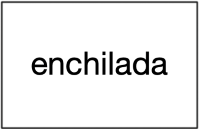
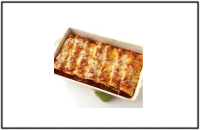
On flashcards for objects, people, or anything that is not abstract (e.g., “house,” “cat,” “food,” or “mother”) use a recognizable picture of that thing instead of a definition in English. This helps you learn to think in the language, instead of just translating from English. Pictures are also easier to remember than words.
To find an appropriate image, google the word in the target language and find a good picture to copy and paste into an electronic flashcard.
- Define abstract words using words that you already know.
While the most difficult or culturally specific abstract words may require English definitions, to define most abstract words (e.g., words like “freedom” or “importance” that don’t refer to a particular physical thing) it is best to use a definition in the target language. Essentially, try to explain it in simpler terms like a native speaker would.
Create your definition and look up any other words that you don’t know to complete it, adding those words to your memory system as you go. Then put the definition on one side of a flashcard, with the abstract vocabulary word on the other.
- For grammatical words, words like prepositions and conjunctions that serve to join other meaningful words, see Flashcards for Grammar.
- NOTE: The front and back of your flashcards should each contain only one or two items of information. If you put too many things, it makes them harder to remember. If you want to remember a word in more than one way (e.g. using both a cloze card with an example sentence and also definitions in the target language), make one flashcard for each strategy that you have chosen.
Flashcards for Grammar
Flashcards for Grammar
Flashcards (Why Use Flashcards?) are certainly excellent tools for learning vocabulary, but they can be applied to other parts of a language as well. One of the toughest things to get a hold on can be the grammar, orthe abstract words and methods of joining together the nouns and verbs to make meaningful units. Instead of memorizing grammar charts and lists of abstract words, try the following method to learn and retain new grammar that you encounter:
Gapped Sentence Cards
- Use gapped examples of sentences that contain a particular grammatical word or construction to make new flashcards. These are also called ‘cloze’ cards.
- For example:
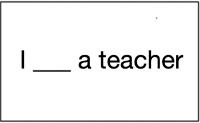
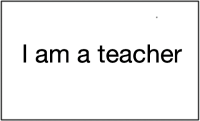
You are learning English and want to remember that you say “I am…”, not “I is/are…”. So the front of your card would be something like “I __ a teacher”, and the back would be “I am a teacher”.
- This way, you can practice real sentences you encounter and learn the grammar in context, instead of memorizing charts or isolated forms of words.
Supplementary Methods
- You can also combine this method with pictures or other hints:
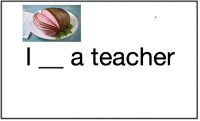
- You could also put “to be” in parentheses so you recall the verb, but still have to remember the specific form. The front of the card would look like “I __ a teacher (to be)”. The more associations you can make with a word, the easier it will be to remember.
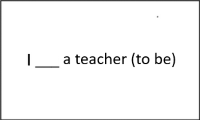
Mnemonic Devices
Mnemonic devices are systems that can help you improve your capacity of remembering things. They are memory techniques to help your brain retain and quickly recall important information. These methods often involve associating what you want to remember with an image, a word or a sentence. Mnemonic devices have been used since the time of Ancient Greece and beyond and can be useful for learning difficult words and phrases in a foreign language.
- One of the most common techniques is known as memory palace or method of loci. In this technique, the items to be remembered are associated with a mental picture of a known physical location, such as your home or your place of work. Within that space, you create a trajectory and put in images that represent the elements that need to be memorized in the middle.
- Creating interesting (and sometimes bizarre) associations helps you remember the elements better. For example, if you need to know that the German word raupe means caterpillar, you could have a caterpillar with a rope around its body.
Articles about Mnemonics on the Web
- Wikipedia has a very well-sourced, detailed article on different kinds of mnemonics.
- The website Fluent in Three Months has a good free article that gives you a Step-by-Step Guide to Making a Memory Palace, and other free resources.
Notebook Systems
One way to record and remember information is to make use of notebooks. A notebook system is an effective way to keep track of all the things you learn over a period of time, and it can form a sort of external memory for you. Writing and organizing what you learn will also help you remember what you learn in class.
You can also combine this method with flashcards and mnemonic devices (See: Why Use Flashcards? and Mnemonic Devices) for more targeted memorization. But you can’t just write things down at random if you want to learn effectively, so you need to organize your notebook for language study. Try the following tips to make effective use of your notebook:
- Divide your notebook into sections, such as vocabulary, grammar, sounds, and (if your language has a different script) letters/symbols. You might think of more categories, which is fine. Having an organized system is what is important.
- When you encounter new words, add them to the appropriate section, with the word on one side and the definition and other relevant grammatical information on the other side. You might want to add examples of the word being used from your textbook too.
- When you find new grammar, don’t organize it into a chart, instead pull examples of the grammar from your book or conversation sessions in use so you can see and recall how it is used. You can also use these examples to make flashcards: Flashcards for Grammar.
- With sounds and letters/symbols, write them down with an example of their being used. You can also draw pictures or hints that help you recall the sound.
- You will be constantly adding new information to your notebook from class and your book. Set time aside each week to review a portion of the older material before intensively studying the newer material. At the end of a semester you will be able to look back at everything you have done in the notebook and do a comprehensive review.